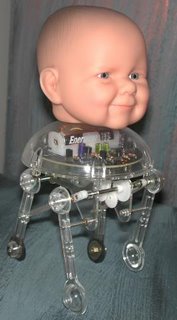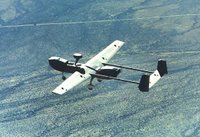Remember, the first
Robot Gossip Contest is to identify when civilization as we know it has become dependent on robots.
It may have already happened but, so far there is no winner in the Robot Gossip Contest.
Most importantly keeps your comment posts and emails coming. Also, here is some update information...
This update includes 3 points:
1. How can you win?
2. Ideas that may already be winners.
3. ATM's are not robots.
How can you win the first Robot Gossip Contest?Let me start explaining this by a negative example. An email or comment that says something like, "What about welding robots?" or "What about bomb robots?" cannot be taken seriously as a contest entry. I do need some kind of evidence - at least in the for of links to pages that might give the evidence. I gave an examle in the origninal posting.
Which brings me to the second point:
Ideas that may already be winners.I have the feeling that JakeH (see
comments) may be on to something by saying that the electronics industry, and so, modern civilization, is already dependent on robots. It was seconded by others in comments and emails. However, no one has really come up with any real examples of machines, companies or descriptions of processes as concrete examples.
It would also be nice to know when and why this happened. For example: "Since Semifacturing broke the sub-milli-bar limit with the Megon chips in 1998, things have never been the same." Something like that, but with real words and some links for reference. I will do some research but not all of it. If I do all the research then I would win the contest and that would just be silly.
Another area that may qualify is welding. Robot welders, it seems, have so much better capabilities than humans that many products - from hand tools to jets to ships - would not be possible without them. The robots are able to make ultra-accurate repeatable welds, self-inspect, collect statistics and adapt to changing conditions. However, I have not found evidence yet that we are truly dependent on these enhance welding skills.
This contest is not meant to be a guessing game. I do not a preconceived idea for a winning entry. So you can keep sending your ideas, like, "What about that robot? from that car company in japan? You know, the one that dances? The white one?" But the winner must show their work.
ATM's are not robots.
Finally, the suggestion that we have become completely dependent on ATM's is probably correct. But ATM's are not robots, they are Kiosks.
What is the difference, you ask? Kiosks are sort of robots inside-out. They may think like robots but they act like part of the geography. By that, I mean that they are part of the landscape, or service desk or architecture. That is how they have so effectively crept into every thing

. Kiosks are sneaky.
An ATM might be considered a robot if it were turned inside out - like if it had mechanical fingers that counted out the money and handed ot to you. Or if they had some kind of real social interaction. For example if, instead of acting like a smart spot on the wall, they came out on the sidewalk to get people to talk to them, "Hey! You! You look like you need some cash! C'mere! Check out my cash box!" You know, weaving in and out of the pedestrians, hitting on the ones that made eye contact. Then I might admit that those sidewalk ATM's were robots. Today they are kiosks.
Kiosks have already taken the banks, gas stations, airports and just about all other public transportation. They are quickly moving into
fast food, hotels, car rentals, grocery stores and discount departent stores. They will soon become so pervasive that the job of 'cashier' will be an odd nostalgic memory.
"Remember back at the turn of the century when they had people whose whole job was to press the keys on the cashier? Like at McD's you say,'I want a hamburger' and they press the hamburger key. 'I want french fries' and they press the french fries key. Man, people must have been stupid back then!"
According to an article in Self Service World magazine (formerly Kiosk magazine) there are 439,000 kiosk units in North America, 157,000 in Asia-Pacific, and 129,000 in Europe. And the numbers are growing exponentially. They are not only replacing human workers but they can also do the jobs more quickly, more accurately and offer more services. Kiosks, ATM's in particular, are a good example of a technology that we have become dependent on. But kiosks are not robots.
Keep the ideas coming!



















































